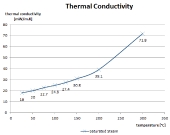Shilo, are you in Palestine?
I cannot read the specification for gallons per minute (or litres), ill look it up. You will want to pump fluid to your collector at a rate of .5 to 1 gallon per minute maximum for a 4x8 collector depending on its efficiency and tilt, orientation, etc. I am guessing the lowest speed available will be suitable. You are looking to get a 10 deg.F rise in temp between the collector feed and return, 20 deg.F max. This indicates efficiency.
There is a pipe plug on the top of your tank, visable in the photo. That is the place to plumb a over-temerature/ over pressure relief valve. They are common and there should have been one on the tank when it was a water heater. It looks like a 90° fitting with a lever for manual operation. It would likely have had a stem pointing to the floor. You can re-build/ replace that device and place a 1-2 gallon container under it or send it out the wall and point it downward. Make it long enough inside to avoid conducting its heat away and freezing (probably not an issue for you) linked example below.
It is not needed for drainback.
Ther are also over pressure valves for boilers that do not include overtemp, some are adjustable.
https://www.homedepot.com/p/Rheem-PROTECH-3-1-4-in-Standard-Shank-Water-Heater-Temperature-and-Pressure-Relief-Valve-SP12574/205651345
A simple line voltage snap disk (around 10$, preferrably an adjustable one, can control your pump, it goes as close to the collector output manifold as possible, you can tuck it in against the pipe leaving the collector, wedged in the grommet that it passes out of the box or tight against the pipe, just outside. Insulate it well, but do try for contact with the metal of the plumbing. It can also be placed high inside the box.
This is not as efficient as a differential controller and tank and collector sensor array, but is quite workable if controls are hard to come by.
You will want some way of monitoring temps, mercury type thermometers, aquarium temp indicators (the lcd tape kind) cooking probes, non contact types, your hands or other.
Your system may be able to survive mild freeze overnight, if it will thermosyphon in its present arrangment. Feel the pipe feeding (foot of collector usually) the collector in the middle of the night on a cool night. If it is good and warm, it is thermosyphoning. You are losing heat also, though.
The above scenario is unlikely and is also a risk, Peter was good to suggest running the pump at night on freezing nights, but it is also only as reliable as the operator. Controllers mostly do not have this function anymore, as even that is not reliable enough to risk expensive collectors on.
Drainback is likely the best option, it does not require exotic and toxic fluids and gravity is most reliable.
To drain back, the plumbing simply is arranged to drain. The collector outlet is high corner and the inlet low corner. A slight off level, one inch or so over 4 feet width (side to side) produces the high corner. You will want a "T" fitting and a short stalk pointing straight upward. Make it long enough so that when the pump turns on, no fluid spills out. This could be from a couple inches to a foot, depending, insulate it.
You could install a vaccum breaker. You could easily build one. It will keep heat better and avoid a gangly pipe up top.
Fill the tank just to the top. The over pressure valve could be located low. This will keep it wet and free of heavy deposits of minerals. Test the valve often to keep it free and check that it opens easily.
Do you have access to a controller?







































































































